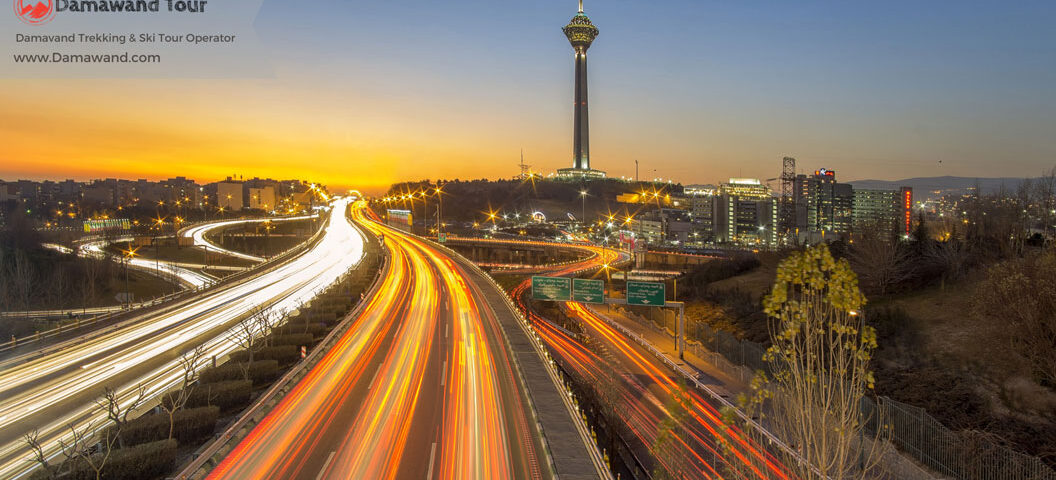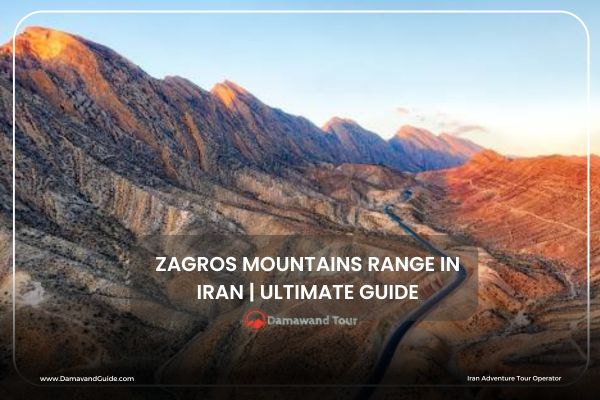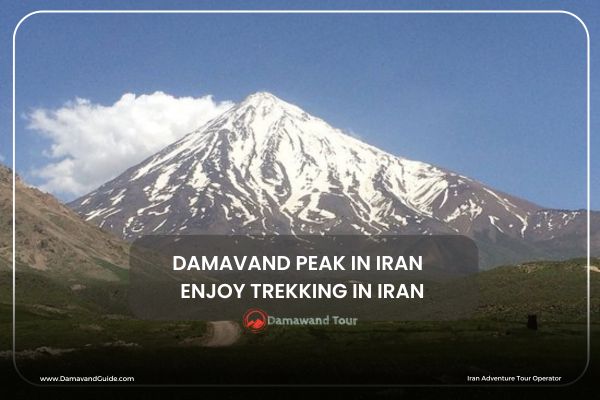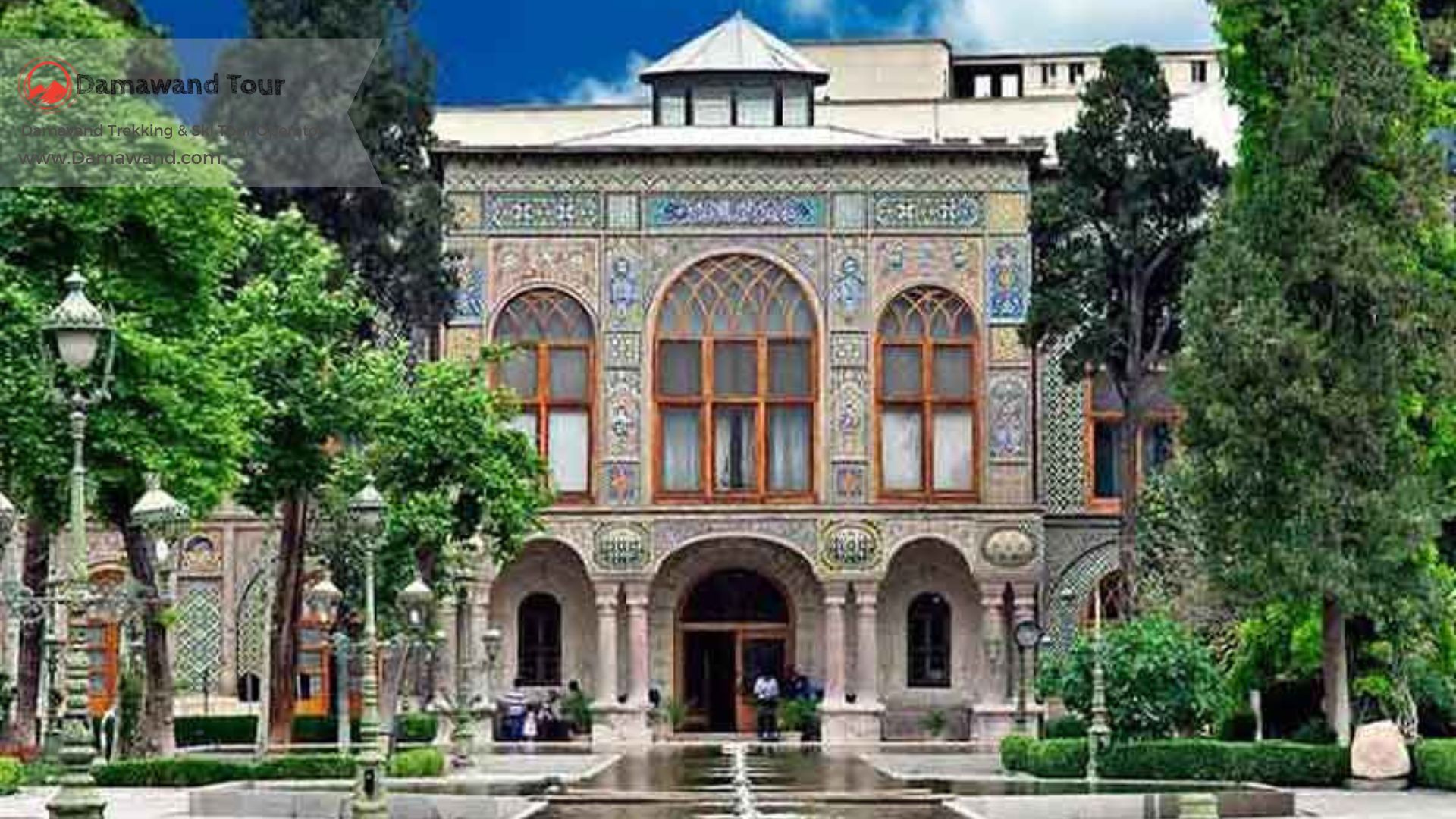
Trip to Iran: Exploring the Rich Cultural Tapestry of Persia
August 12, 2023
Alborz Mountain Range in Iran
October 28, 2023Iran Tourism: Explore the Beauty of Persia’s Rich Cultural Heritage
Iran Tourism offers a unique and unforgettable travel experience. Iran, often referred to as Persia, is a land that has captivated travelers for centuries. With its stunning architecture, historical sites, breathtaking landscapes, and welcoming locals. In this comprehensive guide to Iran tourism, we will take you on a journey through the highlights of this remarkable tourist destination, from the bustling bazaars of Tehran to the top of Asia’s highest volcano mount Damavand and the ruins of Persepolis.
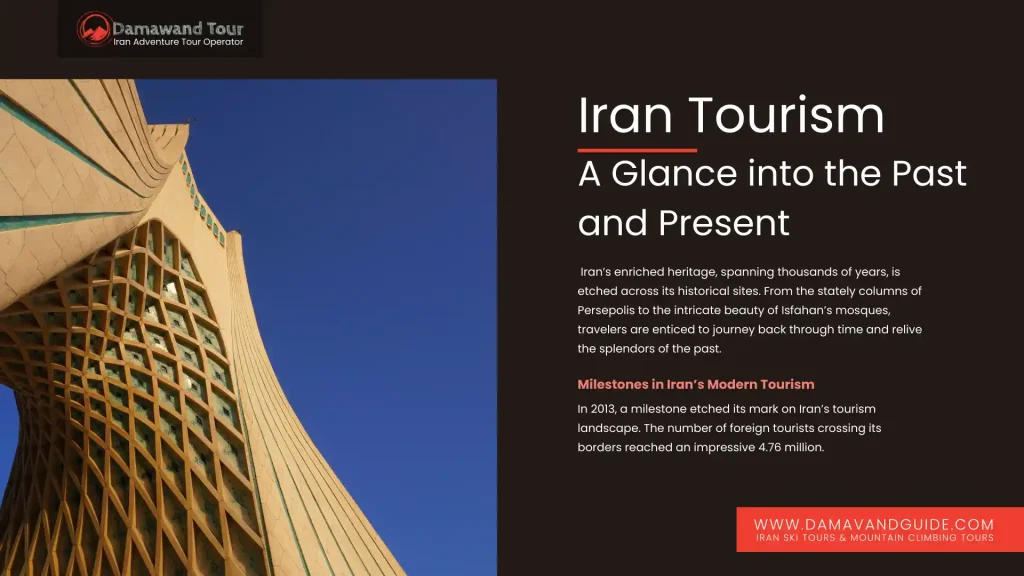
Iran Tourism: A Glance into the Past and Present
Explore the captivating realm of Iran tourism, where the echoes of history reverberate through its diverse attractions. Iran’s enriched heritage, spanning thousands of years, is etched across its historical sites. From the stately columns of Persepolis to the intricate beauty of Isfahan’s mosques, travelers are enticed to journey back through time and relive the splendors of the past.
Pre-Revolutionary Iran Tourism
Before the upheaval of the Iranian revolution in 1979, Iran’s allure for tourists was grounded in its multifaceted attractions. Encompassing cultural riches and a diverse, picturesque landscape, the nation beckoned visitors seeking various activities.
The revolution marked a turning point, shifting the composition of foreign visitors. Religious pilgrims and business travelers became the majority. Iran, a sanctuary of Shi’ite Shrines, boasts the prominent Imam Reza Shrine in Mashhad and Fatimah al-Ma’sūmah Shrine in Qom. These revered sanctuaries witness millions of pilgrims annually, not only from Iran but also from other Shi’ite nations.
A Flourishing Iran Tourism Industry
Even during the 1980s, when the Iran-Iraq War posed adversity, Iran’s tourism sector exhibited remarkable tenacity. Emerging from the shadows of conflict, the industry displayed remarkable resilience. By 2010, domestic tourism within Iran had grown among the world’s largest.
Milestones in Iran’s Modern Tourism
In 2013, a milestone etched its mark on Iran’s tourism landscape. The number of foreign tourists crossing its borders reached an impressive 4.76 million. This inflow, contributing over US$2 billion to the national economy, highlighted the sector’s substantial economic impact. The substantial devaluation of the Iranian Rial since 2012 played a pivotal role in igniting this surge in tourism.
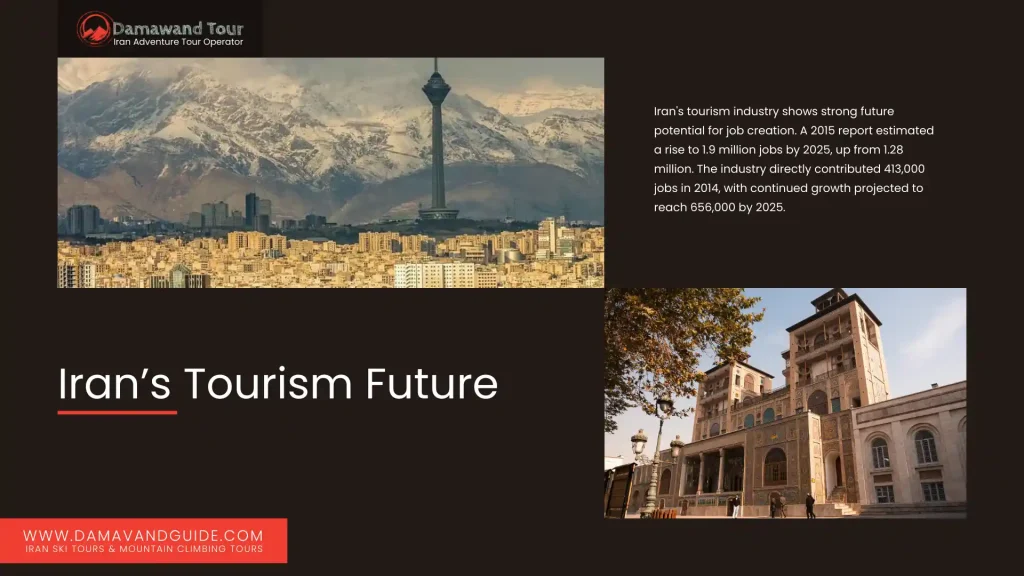
Iran’s Tourism Future
Iran’s tourism industry’s future appears promising on the employment front. A 2015 report by the World Travel and Tourism Council projected the creation of a significant number of jobs. The potential swells to an estimated 1,913,000 jobs by 2025, reflecting a steady rise from the existing 1,285,500. The industry’s growth was evident in its direct contribution to employment, witnessing 413,000 positions in 2014. This growth trajectory was predicted to be sustained, targeting 656,000 jobs by 2025.
Iran’s Tourism Achievements
In October 2018, Ali Asghar Moonesan, the head of Iran’s Cultural Heritage, Handicrafts, and Tourism Organization, made a momentous announcement. The first six months of the Iranian year showcased a remarkable 51 percent surge in tourist arrivals, a testament to the allure of a trip to Iran. This resurgence not only celebrated a significant achievement but also underscored Iran’s resolute return to the forefront of the global tourism map.
Exploring Tehran: Capital City Of Iran
As the capital city of Iran, Tehran seamlessly blends the old and the new, offering a captivating experience for Iranian tourism. Golestan Palace stands as a testament to the opulence of Iran’s Qajar dynasty, while the bustling Grand Bazaar provides a window into the vibrant market culture that has shaped the nation. The National Museum of Iran houses a remarkable collection of artifacts, providing profound insights into the country’s history and evolution.

Dynamic Attractions and Cultural Marvels in Tehran
Tehran, the bustling capital of Iran, pulsates with energy and offers a myriad of experiences for travelers. From the opulence of the Golestan Palace to the tranquility of the Carpet Museum, every corner of Tehran narrates a story of its rich heritage. The National Museum of Iran stands as a testament to the nation’s ancient past, showcasing artifacts that span centuries.
Contemporary Facets and Modern Ambiance
Beyond its historical gems, Tehran also embraces the modern. The Milad Tower, an iconic structure, graces the skyline, offering panoramic views of the city. Sa’dabad Complex, a former royal residence, seamlessly combines history with art, boasting museums and lush gardens that invite leisurely strolls.
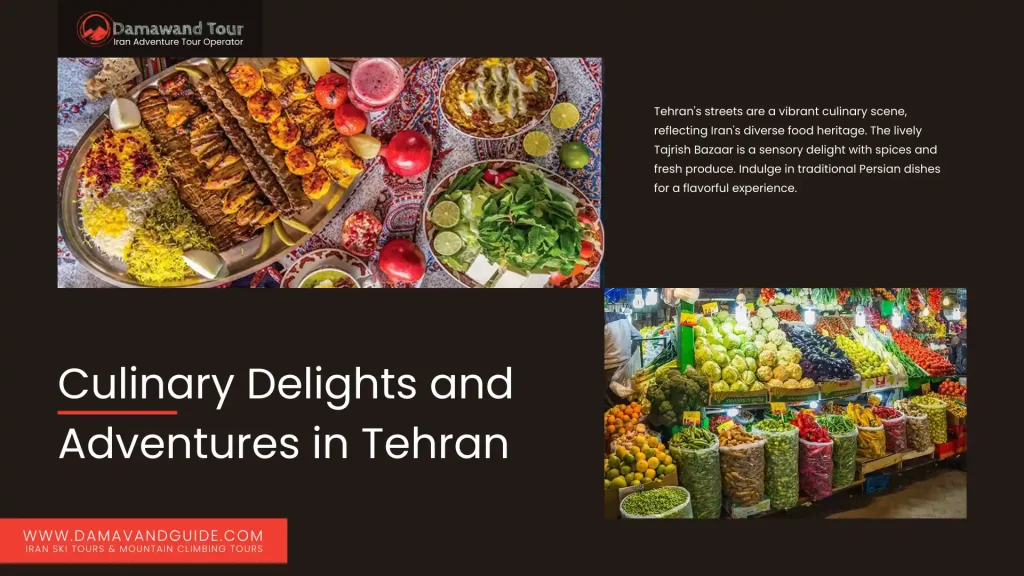
Culinary Delights and Adventures in Tehran
Tehran’s streets are a culinary playground, a testament to Iran’s diverse culinary heritage. The bustling Tajrish Bazaar offers a sensory feast, where the aroma of spices mingles with the vibrancy of fresh produce. Don’t miss the chance to savor traditional Persian dishes, a symphony of flavors that tantalize the taste buds.
Creative Vibes in Visiting The Capital City of Iran
Art enthusiasts will find solace in Tehran’s thriving art scene. The Tehran Museum of Contemporary Art houses an impressive collection of both Iranian and international artworks. Engage with local artists at independent galleries that dot the city, providing insight into the pulse of Tehran’s creative heart.
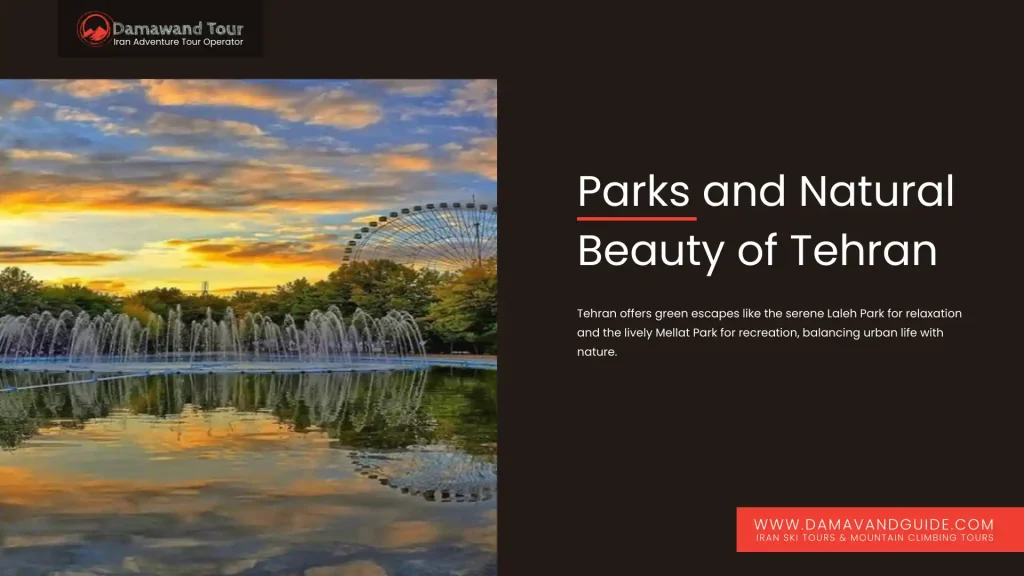
Parks and Natural Beauty of Tehran
Amidst the urban hustle, Tehran offers pockets of green serenity. The lush expanse of Laleh Park provides a refreshing escape, perfect for picnics and leisurely walks. The Mellat Park, bustling with recreational activities, reflects the city’s commitment to balancing nature and modernity.
Shopping and Retail Therapy in Tehran
Tehran delivers for those seeking retail therapy. The Grand Bazaar, an age-old marketplace, beckons with its labyrinthine alleys, where treasures ranging from carpets to spices await discovery. Saunter through modern malls for a glimpse into Tehran’s contemporary shopping culture.
Travel Tehran: Tips for Travelers
As you explore Tehran city, remember to explore its local customs and etiquette. Modesty in dress is appreciated, especially in religious sites. Greet locals with a warm “Salam” and indulge in the rich tapestry of Persian hospitality.
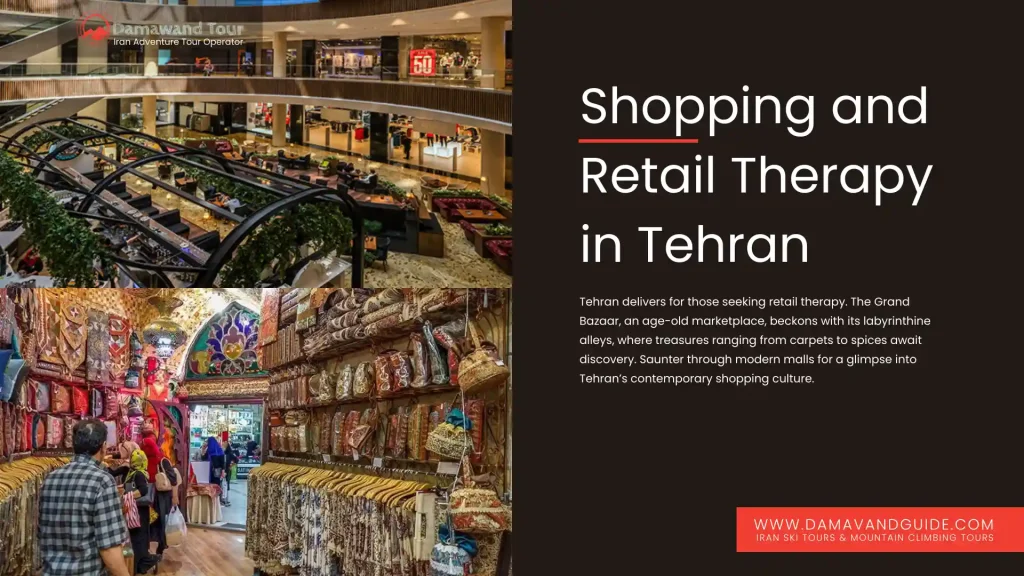
Iran Beautiful Landscapes: From Iran Deserts to Iran Mountains
Mount Damavand in Iran and the Lut Desert are majestic testaments to Iran’s untouched landscapes, each extending an irresistible call to adventurers in Iran tourism . They beckon with unique offerings, from conquering peaks to traversing the enchanting silence of deserts. These wonders vividly remind us that Iran’s borders cradle landscapes that stir the soul and share tales of Earth’s power and beauty thriving in its most remote corners.
The allure of Iran’s natural landscapes is equally captivating. The surreal beauty of the Dasht-e Kavir and Dasht-e Lut deserts unfolds through vast sand dunes and endless salt flats that seemingly stretch forever. In contrast, the Alborz mountain range, the home of Mount Damavand, promises thrilling trekking adventures and breathtaking vistas that capture the essence of Iran’s scenic magnificence.
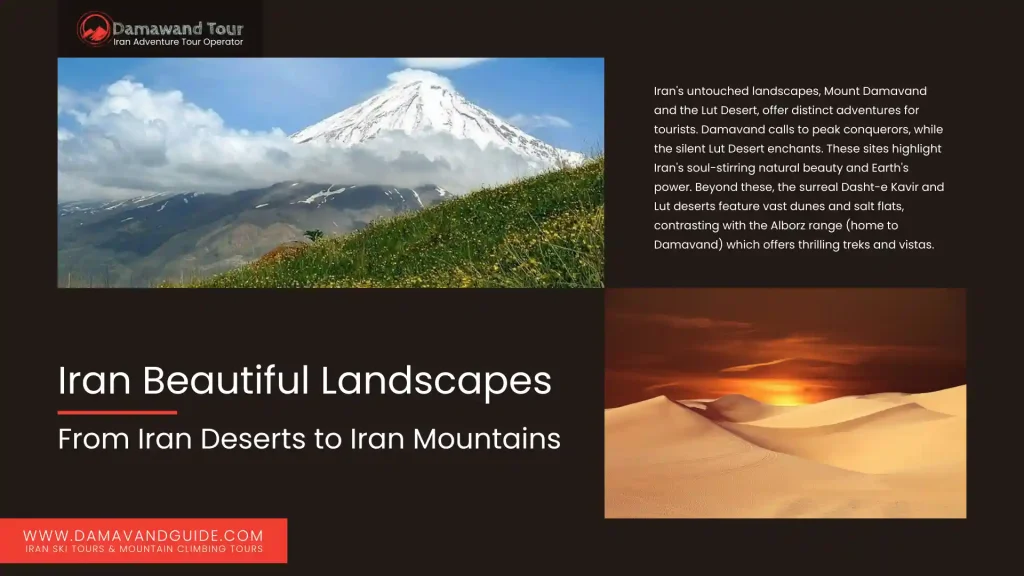
Trekking Mount Damavand: Adventure Journey in Iran Tourism
With its towering presence and snow-capped peak, Mount Damavand symbolises Iran’s rugged beauty. This stratovolcano, draped in myth and lore, beckons climbers and adventurers. Ascending to its summit, at over 5,600 meters, rewards the brave with panoramic vistas that stretch to the horizon.
Mount Damavand isn’t just a peak; it’s a journey that tests physical and mental endurance. Trekking through diverse ecosystems, from verdant meadows to rocky terrain, unveils the wonders of Iran’s natural bounty. The thrill of reaching the summit is a testament to the human spirit’s unwavering determination.
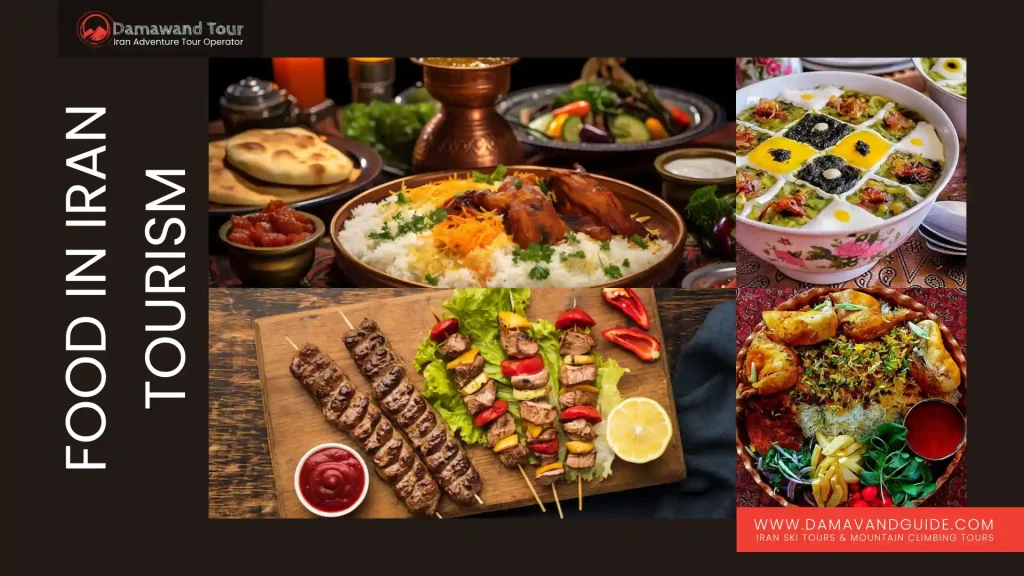
Persian Cuisine: Food in Iran Tourism
An Iran tourism experience remains incomplete without tasting its rich culinary heritage. Iranian cuisine elevates the senses with its flavorful kebabs, aromatic rice dishes, and irresistible stews. Delight in the essence of Iran’s culture by sampling dishes like Ghormeh Sabzi, a herb-laden stew, or treating yourself to the exquisite saffron-infused sweetness of Persian ice cream.
Persian Hospitality: Highlight in Iran’s Tourism
When it comes to Iran tourism, the warmth of Iranian hospitality is renowned. Travelers frequently discover themselves invited into homes for tea, providing a unique opportunity to forge personal connections with locals. This genuine friendliness weaves a tapestry of belonging, enriching the travel experience with an extra layer of authenticity.
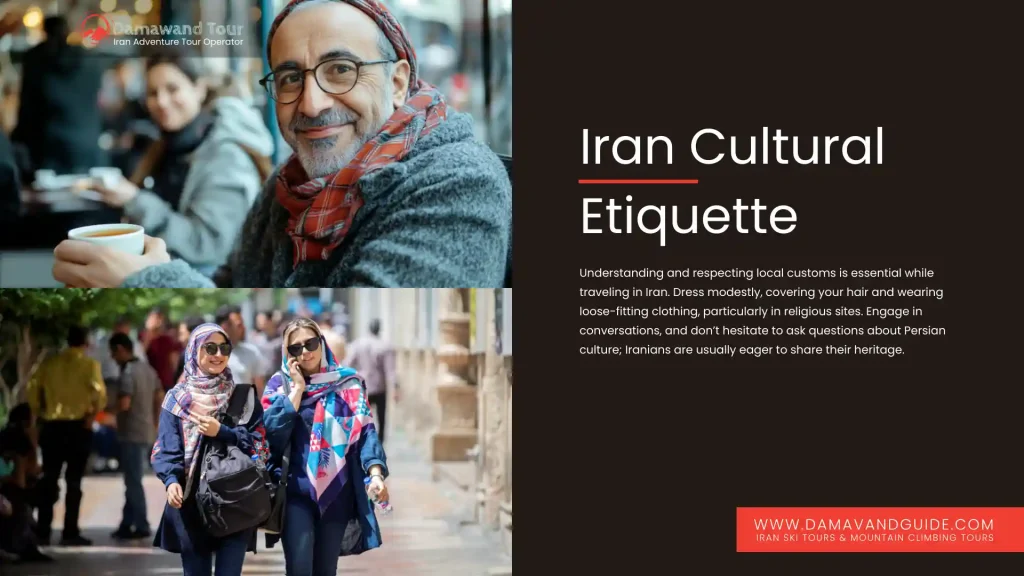
Iran Cultural Etiquette: Navigating Iran with Respect
Understanding and respecting local customs is essential while traveling in Iran. Dress modestly, covering your hair and wearing loose-fitting clothing, particularly in religious sites. Engage in conversations, and don’t hesitate to ask questions about Persian culture; Iranians are usually eager to share their heritage.
Iran Art and Architecture: A Living Legacy
Iran tourism uncovers the nation’s profound cultural heritage through its captivating art and architecture. The intricate mosaic artistry of Nasir al-Mulk Mosque and the breathtaking mirror-adorned halls of Sheesh Mahal stand as testament to Persian craftsmanship and aesthetics. Additionally, the enchanting Abyaneh village showcases traditional adobe architecture, offering a unique glimpse into the beauty of rural life in Iran.
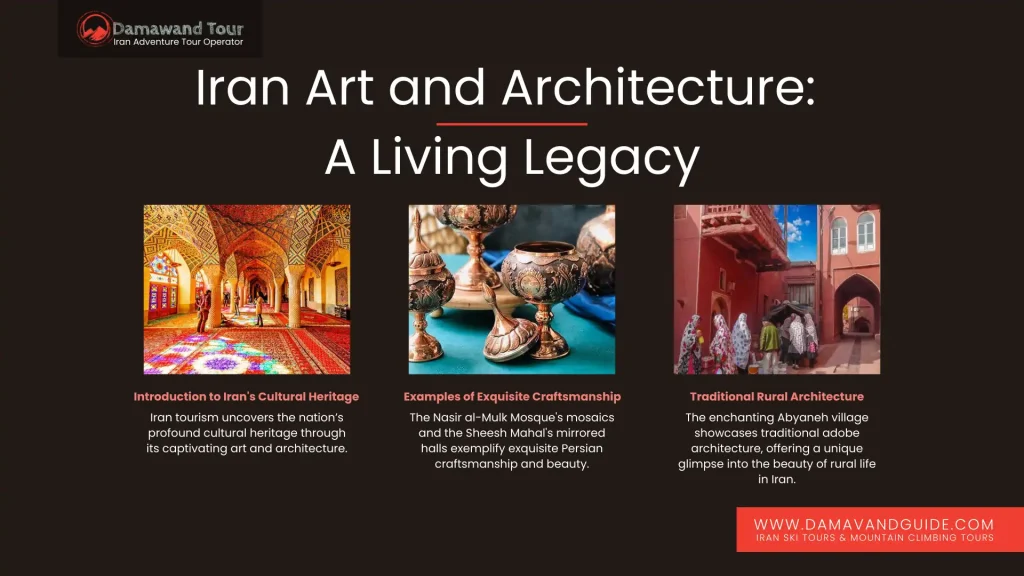
Isfahan City: The Jewel of Persia
Isfahan, known as “Half of the World,” is a city of extraordinary beauty. The Naqsh-e Jahan Square, surrounded by majestic structures, invites you to wander through history. Visit the mesmerizing Imam Mosque and Sheikh Lotfollah Mosque, both architectural marvels adorned with intricate designs.
Political Stability in Iran
Iran has a history of political stability, and the local authorities take measures to maintain peace and security. However, it’s recommended to stay updated on current events and follow any travel advisories issued by your government.
Health Precautions
Just like when traveling to any foreign country, it’s advisable to stay updated on required vaccinations and take necessary health precautions. Additionally, staying hydrated, avoiding consuming tap water, and carrying necessary medications are key components of staying healthy during your trip.
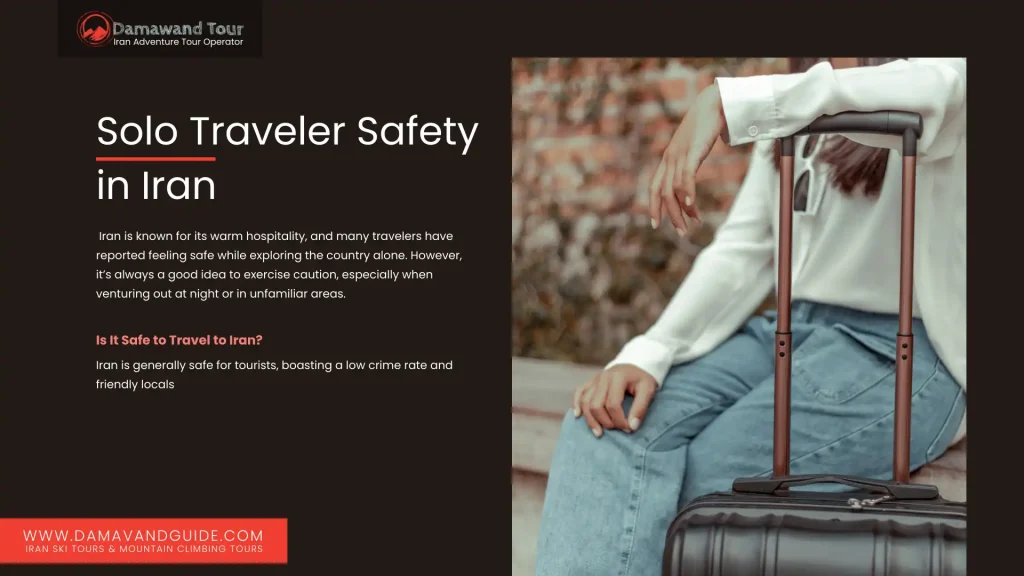
Solo Traveler Safety in Iran
Iran is known for its warm hospitality, and many travelers have reported feeling safe while exploring the country alone. However, it’s always a good idea to exercise caution, especially when venturing out at night or in unfamiliar areas.
Is It Safe to Travel to Iran?
As travelers start their exciting Iran tourism adventures, they’re met with a valid concern: safety. Ensuring a secure journey is paramount, as Iran, like any other destination, comes with its own set of safety considerations that visitors should be mindful of. Iran is generally safe for tourists, boasting a low crime rate and friendly locals. By staying informed about the current situation, following travel advisories issued by your government, and practicing common-sense precautions, you can fully embrace the beauty and culture of this captivating nation while prioritizing your well-being.
Local Advice in Iran
Engaging with locals can provide valuable insights into safety considerations specific to the region you’re visiting. Locals often have the best knowledge of which areas to avoid and how to navigate the local environment safely.
Emergency Contact Information in Travel Iran
Familiarize yourself with the local emergency contact numbers and the location of your country’s embassy or consulate. Having this information handy can be extremely helpful in case of unforeseen circumstances.
Best Time to Visit Iran
Planning a remarkable Iran tourism journey involves thoughtful consideration of the best time to visit this captivating nation. Iran’s diverse landscapes and cultural marvels are intricately intertwined with distinct seasons, each exuding its own unique allure. Spring (March to May) and fall (September to November) emerge as ideal windows for exploring, boasting mild and pleasant weather that invites exploration.
However, it’s important to note that summer can be scorching, particularly in desert regions, while winter blankets mountainous areas with snowfall, offering thrilling opportunities for skiing. To ensure you make the most of your trip to Iran here’s a guide to the most opportune times to immerse yourself in this enchanting destination.
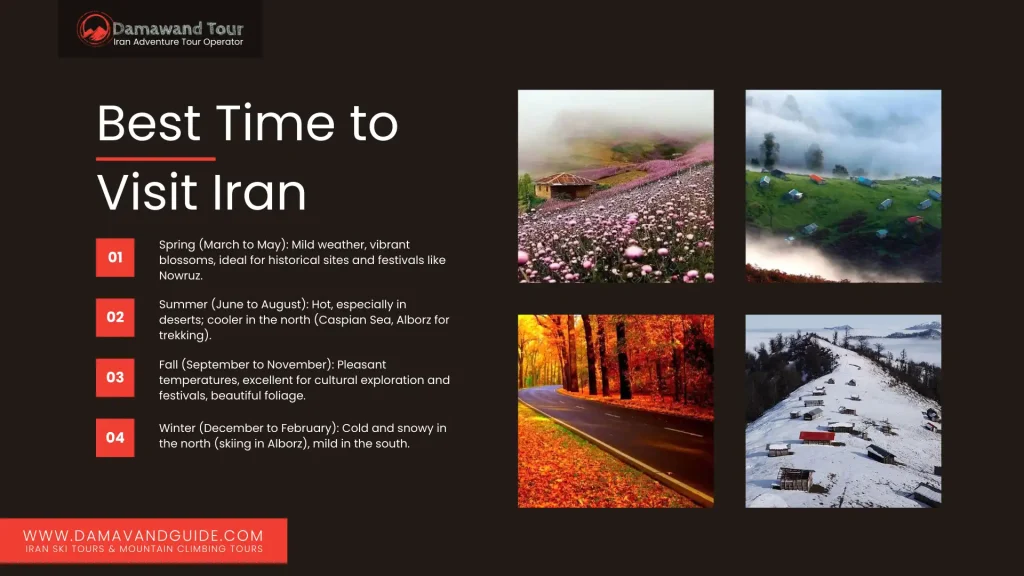
Spring (March to May)
Spring emerges as one of the most sought-after seasons for Iran tourism. As nature awakens from its slumber, the entire country is adorned with a vibrant tapestry of blossoms and greenery. The weather is pleasantly mild, making it an ideal time for exploring historical sites, strolling through gardens, and immersing yourself in local festivities like the Nowruz celebration, marking the Persian New Year.
Summer (June to August)
Summer unveils a diverse Iran, with varying climates across its regions. The northern regions offer a cool escape from the heat, while the southern parts experience scorching temperatures. Coastal towns and northern areas become havens for those seeking relief from the summer sun. Adventure enthusiasts can head to the Alborz mountain range for trekking or indulge in water activities along the Caspian Sea coast.
Fall (September to November)
Fall unveils a magical transformation, as the summer heat gradually gives way to cooler and more pleasant temperatures. This period is an excellent time for cultural exploration, as many festivals and events take place, offering insights into Iran’s traditions and heritage. Additionally, the fall foliage adds a touch of enchantment to the landscapes, making it a favorite among photographers and nature enthusiasts.
Winter (December to February)
Winter sets a unique stage for Iran tourism. While the northern regions experience cold and snowy weather, the southern areas remain mild and inviting. This season is ideal for those seeking an authentic winter experience, with opportunities for skiing in the Alborz mountains or exploring the tranquil desert landscapes.
Finally, the best time to visit Iran largely depends on your preferences and the experiences you seek. Whether you’re captivated by the blossoming spring, intrigued by the cultural festivities of fall, or drawn to the winter wonderlands, Iran tourism offers a diverse array of experiences throughout the year. Plan your trip wisely to uncover the true essence of this remarkable destination.
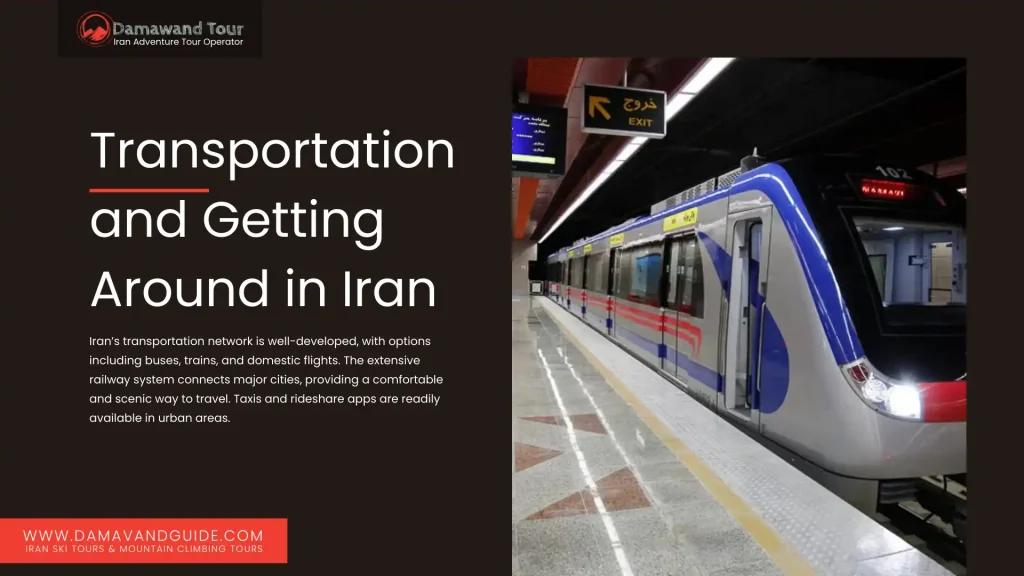
Transportation and Getting Around in Iran
Iran’s transportation network is well-developed, with options including buses, trains, and domestic flights. The extensive railway system connects major cities, providing a comfortable and scenic way to travel. Taxis and rideshare apps are readily available in urban areas.
Currency and Financial Matters
The official currency of Iran is the Iranian Rial (IRR). While credit cards are accepted in some hotels and upscale establishments, it’s advisable to carry cash for most transactions. Money can be exchanged at banks, exchange offices, and some hotels.
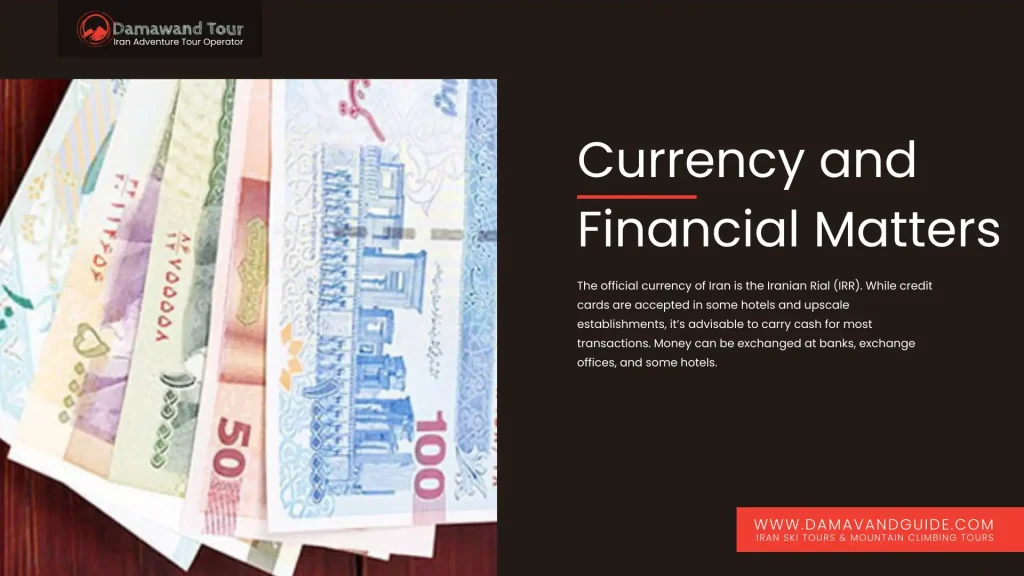
Cultural Fests and Events in Iran
For those interested in Iran tourism, many cultural events and festivals await throughout the year. The Nowruz celebration, a jubilant marking of the Persian New Year, takes center stage with its vibrant festivities. The Tehran International Book Fair and the Fajr International Film Festival also emerge as captivating highlights on Iran’s cultural calendar, enriching the travel experience with artistic and intellectual allure.
Conclusion
Iran tourism offers a remarkable journey through a land of contrasts, where ancient history meets modern vibrancy. From the architectural wonders of Isfahan to the serene landscapes of Qeshm Island, every corner of Iran beckons with a unique story to tell. Immerse yourself in the warmth of Persian hospitality, savour the flavours of its cuisine, and explore the rich tapestry of culture and art that define this nation. As you navigate through bazaars, mosques, and Iran mountains, you’ll find that Iran’s allure lies not only in its attractions but in the genuine connections you’ll make along the way.

